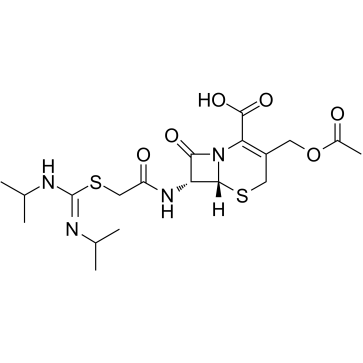CHEMICAL IDENTIFICATION
-
RTECS NUMBER :
-
XI0373000
-
CHEMICAL NAME :
-
5-Thia-1-azabicyclo(4.2.0)oct-2-ene-2-carboxylic acid, 7-(2-((N,N'-diisopropylamidino)thio) acetamido)-3-(hydroxymethyl)-8-oxo-, acetate
-
CAS REGISTRY NUMBER :
-
33075-00-2
-
LAST UPDATED :
-
199406
-
DATA ITEMS CITED :
-
2
-
MOLECULAR FORMULA :
-
C19-H28-N4-O6-S2
-
MOLECULAR WEIGHT :
-
472.63
-
WISWESSER LINE NOTATION :
-
T46 ANV ES GUTJ CMV1SYMY1&1&UNY1&1 G1OV1 HVQ
HEALTH HAZARD DATA
ACUTE TOXICITY DATA
-
TYPE OF TEST :
-
LD50 - Lethal dose, 50 percent kill
-
ROUTE OF EXPOSURE :
-
Intraperitoneal
-
SPECIES OBSERVED :
-
Rodent - mouse
-
DOSE/DURATION :
-
1260 mg/kg
-
TOXIC EFFECTS :
-
Details of toxic effects not reported other than lethal dose value
-
REFERENCE :
-
CMJODS Chinese Medical Journal (Beijing, English Edition). (China International Book Trading Corp., POB 2820, Beijing, Peop. Rep. China) V.1- 1975- Adopted vol. no. 92 in 1979. Volume(issue)/page/year: 92,26,1979
-
TYPE OF TEST :
-
LD50 - Lethal dose, 50 percent kill
-
ROUTE OF EXPOSURE :
-
Intravenous
-
SPECIES OBSERVED :
-
Rodent - mouse
-
DOSE/DURATION :
-
720 mg/kg
-
TOXIC EFFECTS :
-
Details of toxic effects not reported other than lethal dose value
-
REFERENCE :
-
CMJODS Chinese Medical Journal (Beijing, English Edition). (China International Book Trading Corp., POB 2820, Beijing, Peop. Rep. China) V.1- 1975- Adopted vol. no. 92 in 1979. Volume(issue)/page/year: 92,26,1979
|

